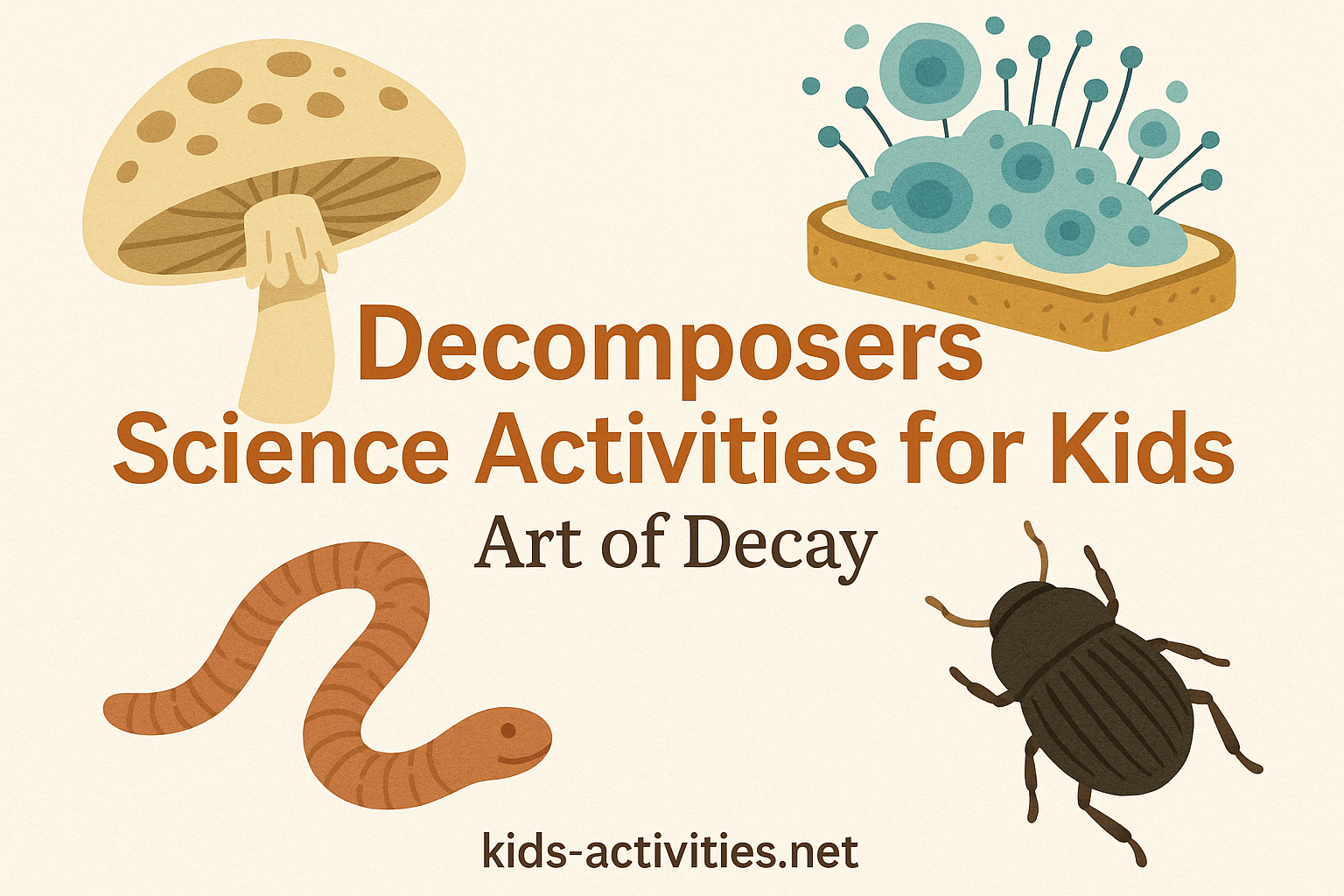
Decomposers science activities for kids
Why Understanding Decomposition Matters
Have you ever wondered what happens to fallen leaves, discarded food, or dead trees in nature? Without decomposers, our planet would be buried under layers of waste, and essential nutrients would be locked away, making new life impossible.

Yet many children (and even adults) rarely get a close-up look at the fascinating world of decay. The invisible work of fungi, bacteria, and insects remains a hidden but crucial part of our natural systems.
Quick Resource: Download our “What Are Decomposers?” Quick Guide (PDF)
Learning about decomposers helps kids:
- Understand nature’s recycling system
- Build respect for small creatures and fungi
- Discover how life and death are interconnected
- Appreciate the balance of ecosystems
The Secret Science Behind Decomposition
Decomposition is a complex, collaborative process where many organisms team up to break down dead material.
Main Players:
- Fungi: Break down tough organic materials like cellulose and lignin.
- Bacteria: Start the softening process, especially in moist environments.
- Insects: Shred materials and help spread decomposer spores.
- Earthworms: Enrich soil by digesting organic matter and excreting nutrient-rich waste.
Key Concepts for Kids:
- Fungal Networks: Some fungi create vast underground webs (mycelium) that connect plants and transport nutrients.
- Microbial Succession: Different microbes take over as decomposition progresses.
- Temperature and Moisture Impact: Decomposition speeds up with warmth and water but slows down in dry, cold conditions.
Hands-On Activities: Exploring the Art of Rot
Free Activity Kit: Download our “Decomposition Science Activities for Kids” (PDF)
Here are two exciting activities that turn decomposition science into an unforgettable learning journey:
1. Fungal Networks: Visualising Mycelium with Mouldy Bread Maps

Materials:
- Several slices of white bread
- Plastic zip-lock bags
- Water spray bottle
- Permanent markers
- Observation sheet
- Magnifying glass (optional)
Instructions:
- Lightly spray bread slices with water.
- Seal each slice inside a labelled zip-lock bag.
- Store in a dark, warm place.
- Check daily for signs of mould growth.
- Use a permanent marker to map different colours and textures on the bag surface as mould appears.
- After a week or two, compare how different slices look. Which ones grew the largest “networks”?
Learning Points:
- Identify different types of fungi based on colour.
- Discuss how fungi spread through invisible threads.
- Understand environmental factors that influence growth.
2. Insect Digesters: Testing Decomposition Efficiency

Materials:
- Mealworms, crickets, or compost beetles
- Clear plastic containers with lids
- Three types of organic material (e.g., carrot peels, newspaper strips, leaves)
- Kitchen scale
- Timer or daily schedule
Instructions:
- Place an equal weight of each material in separate containers with insects.
- Record starting weights.
- Monitor daily for material changes.
- After one week, weigh remaining materials.
- Compare which material was decomposed fastest!
Learning Points:
- Different insects digest different materials more efficiently.
- Organic material type affects decomposition speed.
- Biological recycling happens at different rates depending on species.
Extra Exploration

Want even more ways to discover decomposition without too much extra setup? Try these:
Compost Temperature Tracker
- Insert a simple soil thermometer into an active compost pile.
- Record temperatures morning and evening for a week.
- Graph results to observe microbial heat generation patterns.
Bioluminescence Hunt
- Research bioluminescent fungi (like Armillaria mellea).
- If possible, carefully observe forest logs at night to spot natural glow.
- If not available, watch online videos together and discuss!
Downloadable Resources
Mould Map Observation Sheet (PDF)
Insect Digestion Chart Template (PDF)
Compost Temperature Log (PDF)
Visit our kids-activities.net for more activities!




